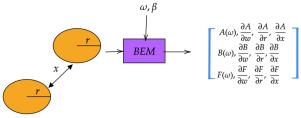波-结构相互作用水动力敏感性分析的完全可微边界元求解器
IF 4.4
2区 工程技术
Q1 ENGINEERING, OCEAN
引用次数: 0
摘要
准确预测波浪与结构的相互作用对海洋结构的有效设计和分析至关重要。这通常是通过采用边界元法(BEM)的求解器来实现的,该方法依赖于线性势流理论。精确估计这些相互作用的灵敏度对于设计优化等系统级应用同样重要。目前的BEM求解器无法提供这些灵敏度,因为它们不支持自动区分(AD)。为了应对这些挑战,我们开发了一款完全可微分的BEM求解器MarineHydro。Jl,用于海洋流体动力学,能够高精度地计算衍射和辐射系数及其导数。MarineHydro。jl实现了直接和间接BEM公式,并结合了两个格林函数表达式,在精度和计算速度之间进行了权衡。梯度是在Julia编程语言中使用反向模式AD计算的。作为第一个案例研究,我们分析了两个相同的浮动球体,评估了物理尺寸、球间距离和波频率方面的梯度。验证研究表明,ad计算的梯度与有限差分结果之间具有良好的一致性。在第二个案例研究中,我们利用ad计算的梯度来优化一对波浪能转换器(WECs)的机械功率生产。这代表了从边界元求解器获得的精确梯度在WEC功率优化中的首次应用。这两项研究都为水动力相互作用提供了有价值的见解,并促进了对布局优化的理解。除了功率优化之外,可微分边界元求解器还突出了AD在海上设计研究中的潜力。它为在机器学习集成、最优控制和水动力系数不确定性量化方面的更广泛应用铺平了道路,为推进波结构相互作用分析和系统级优化提供了新的方向。本文章由计算机程序翻译,如有差异,请以英文原文为准。

Fully differentiable boundary element solver for hydrodynamic sensitivity analysis of wave-structure interactions
Accurately predicting wave-structure interactions is critical for the effective design and analysis of marine structures. This is typically achieved using solvers that employ the boundary element method (BEM), which relies on linear potential flow theory. Precise estimation of the sensitivity of these interactions is equally important for system-level applications such as design optimization. Current BEM solvers are unable to provide these sensitivities as they do not support automatic differentiation (AD). To address these challenges, we have developed a fully differentiable BEM solver, MarineHydro.jl, for marine hydrodynamics, capable of calculating diffraction and radiation coefficients, and their derivatives with high accuracy. MarineHydro.jl implements both direct and indirect BEM formulations and incorporates two Green’s function expressions, offering a trade-off between accuracy and computational speed. Gradients are computed using reverse-mode AD within the Julia programming language. As a first case study, we analyze two identical floating spheres, evaluating gradients with respect to physical dimensions, inter-sphere distance, and wave frequency. Verification studies demonstrate excellent agreement between AD-computed gradients and finite-difference results. In a second case study, we leverage AD-computed gradients to optimize the mechanical power production of a pair of wave energy converters (WECs). This represents the first application of exact gradients obtained from BEM solver in WEC power optimization. Both studies offer valuable insights into hydrodynamic interactions and advance the understanding of layout optimization. Beyond power optimization, the differentiable BEM solver highlights the potential of AD for offshore design studies. It paves the way for broader applications in machine learning integration, optimal control, and uncertainty quantification of hydrodynamic coefficients, offering new directions for advancing wave-structure interaction analysis and system-level optimization.
求助全文
通过发布文献求助,成功后即可免费获取论文全文。
去求助
来源期刊

Applied Ocean Research
地学-工程:大洋
CiteScore
8.70
自引率
7.00%
发文量
316
审稿时长
59 days
期刊介绍:
The aim of Applied Ocean Research is to encourage the submission of papers that advance the state of knowledge in a range of topics relevant to ocean engineering.
 求助内容:
求助内容: 应助结果提醒方式:
应助结果提醒方式:


